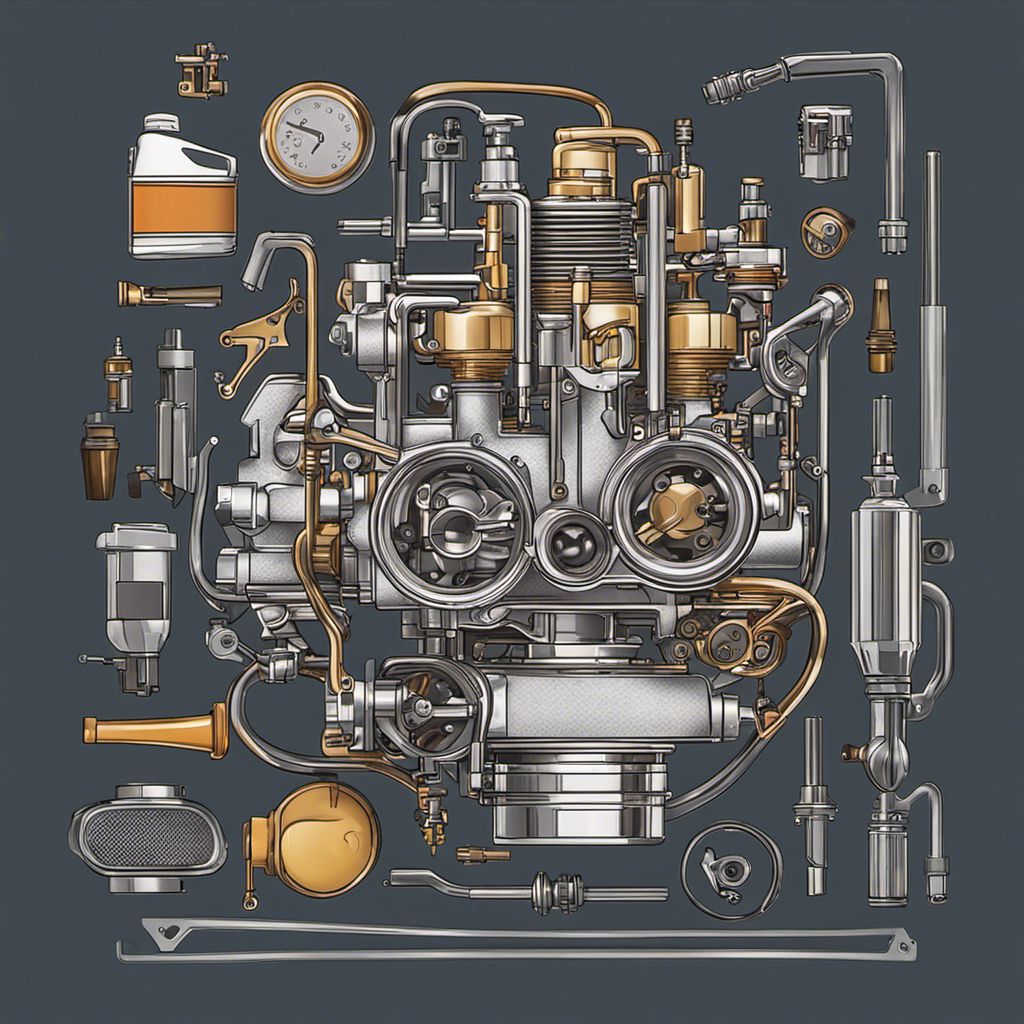Have you ever felt the sharp frustration of an ATV consuming fuel faster than a parched desert soaks up rain? You’re not alone. It appears that giving your vehicle a bit of tender, loving maintenance in the carburetor maintenance department could be quite beneficial.
Like many others, I’ve walked that path and after countless hours spent tinkering and researching, I’ve uncovered just how vital a clean carburetor truly is for boosting that elusive fuel efficiency.
In this post, we’ll journey through each step to thoroughly clean your trusty ATV’s carburetor for peak performance levels, along with other useful tips to help you squeeze every last mile out of your precious fuel reserves.
Ready to make your hard-earned money take you further on those trails?.
Key Takeaways
- A clean carburetor helps your ATV use fuel better. It can also keep other problems away.
- You can clean the carburetor while it’s still on the ATV or take it off first. Each way has good and bad points.
- Keep your ATV light to save fuel. Too much weight makes it burn more gas.
- Regular checks and right tire pressure help too. So do fuel additives and efficient fuel types.
Why Carburetor Maintenance is Important for Optimal Fuel Efficiency

Your ATV needs a clean carburetor to work well. This part mixes gas and air in the right way for your engine. If it’s dirty or not working right, your ATV can’t use fuel in the best way.
You may then see more gas used than needed.
The wrong mix of air and fuel can also lead to other problems. Your vehicle might feel tough to start when it’s cold outside. It might fail an emissions test too. Taking good care of the carburetor now helps prevent these issues later on!
Steps for Disassembling and Cleaning an ATV Carburetor

We’ll walk you through the essentials of how to remove your ATV’s carburetor, disassemble it properly, and meticulously clean each component for optimum performance.
Removing the carburetor from the ATV
First, we turn off the fuel valve on the fuel tank. We do this to keep gas from flowing while we work. Next, it’s time to get the carburetor out. It might be a tough job if you’ve never done it before.
Don’t worry, though! With care and patience, we can do this together. Always move slowly when dealing with parts of an ATV. Mishaps may cause damage to your ride or even injury to you.
Locate the clamps that hold the carburetor in place. There are usually two; one at front and another at back. Loosen them up but don’t take them all off yet! Once loose, the carburetor should slide right off its spot between these clamps.
After that’s done, look out for any wires or tubes connected to it and carefully remove those too using some basic tools like a screwdriver or pliers where necessary.
Disassembling the carburetor
First, we have to find and take off the ATV carburetor. We then remove the float. The next step is taking out the jets of the carburetor. Covers or clamps that are on the outside need to go too.
Going through these steps makes sure all parts of our carburetor get a deep clean later on.
Cleaning the carburetor components
We take apart the carburetor first. Next, we use a cable brush to scrub each part. Then we splash them with carb and choke cleaner. This tool does a great job cleaning the parts. We also spray the cleaner into jet holes, air holes, and idle holes.
They need cleaning too! Old gasoline leaves behind stuff in the carb bowl. To clean this out, we use more spray cleaner inside it. Sometimes there’s still residue left on some parts after all that cleaning.
That’s when we get our toothbrush out to make sure everything is spotless!
Pros and Cons of Cleaning While Attached vs. Disassembling
Let’s dive into the advantages and disadvantages of cleaning an ATV carburetor while still attached versus disassembling it completely.
Advantages of Cleaning While Attached:
– Faster process: You can complete this within a short time due to fewer steps involved. Cleaning while attached is quick and easy, especially for those of us who like to get back on the trails as soon as possible.
– Regular maintenance: It is perfect for routine check-ups and preventing significant issues down the line.
– Less technical: You don’t need to be a carburetor whiz to do this. The process is somewhat straightforward and more comfortable for beginners or less experienced riders.
Disadvantages of Cleaning While Attached:
– Less effective: While it’s fast, cleaning while attached doesn’t offer as deep of a clean. This method largely depends on the amount of dirt and debris accumulation in the carburetor.
– Temporary fix: It’s a short-term solution, especially if the ATV has been running too rich or the engine is flooding. These cases often require a thorough cleaning, which you can only accomplish by disassembling the carburetor.
Advantages of Complete Disassemble and Clean:
– Deep clean: Taking apart the carburetor allows a meticulous cleaning of each component. An ultrasonic cleaner can help in this process, especially during engine restoration.
– Boosts fuel efficiency: A total disassemble and clean can significantly improve fuel efficiency. If your ATV gets bogged down when you apply the throttle, a complete clean may resolve the issue.
Disadvantages of Complete Disassemble and Clean:
– Time-consuming: This method takes time and patience. It’s not the best option if you need to get back on the trail quickly.
– Needs technical knowledge: Disassembling the carburetor requires a decent understanding of ATV mechanics. It’s not the best method for beginners unless they’re guided by an experienced ATV rider or mechanic.
Whether you decide to clean while attached or disassemble your carburetor entirely, the importance of this maintenance can’t be downplayed. It’s crucial for optimal fuel efficiency and the overall performance of your ATV. So, keep that carburetor clean, and enjoy the ride!
Other Ways to Improve Fuel Efficiency for ATVs
Besides regular carburetor maintenance, you can enhance your ATV’s fuel efficiency by keeping the vehicle light, performing routine check-ups, maintaining proper tire pressure, and utilizing efficient fuel or additives.
These simple steps go a long way in saving fuel costs and ensuring peak performance of your ATV.
Keeping the ATV light
We can make our ATV use less fuel by keeping it light. Extra weight makes the engine work harder and burn more gas. We do not load up things we don’t need for a ride. This includes heavy gear and tools, extra fuel, or even a buddy who could ride his own ATV.
Just like with cars, less weight equals better gas mileage on an ATV too! So let’s keep our rides light and zippy to save some gas!
Regular maintenance and proper tire pressure
Let’s talk about how regular maintenance and proper tire pressure help our ATVs.
- Keep a schedule for ATV checks. Like us, our ATVs need to be in shape to work well.
- Tire maintenance is vital. A poorly kept tire can lead to troubles on rides.
- Proper tire pressure links to fuel efficiency. Inflated tires mean we use less gas over the long haul.
- Follow the suggested psi levels for ATV tires. It’s crucial, especially when we go off-roading.
- Be careful not to let out too much air! Just 1 psi less can hurt our fuel efficiency.
- Keep those tires at the right pressure! Doing so could improve our gas mileage by up to 3%.
Using fuel additives and efficient fuel
We can boost the ATV’s fuel efficiency by using fuel additives and efficient fuel. Fuel additives clean up the carburetor, improving how well our ATV uses its gas. They also make sure that the engine runs smoothly and uses less gas over time.
They do this by taking out carbon deposits from engine parts. This leads to better performance and less use of fuel! More so, some additives raise the quality of gasoline which leads to an even burn of fuel in the engine.
This will give us more miles for each gallon of gas we put into our ATV! Not only will we get to enjoy longer rides, but we’ll be saving money on gas too!
Conclusion: Regular Carburetor Maintenance for Long-Term Fuel Efficiency.
Keep your ATV’s carburetor clean. This will make sure your ride uses less fuel. It will also run smoother and go faster. You’ll have a lot more fun that way!
FAQs
1. What is an ATV carburetor?
An ATV carburetor is a part that mixes air and gas in the right amount for your engine to work.
2. Why should I clean my ATV carburetor?
You should clean your ATV carburetor often to make sure it works well and gives you good fuel use.
3. How do I keep my ATV carburetor in good shape?
To keep your ATV carburetor in good shape, try to avoid dirt or dust getting into it, always use clean fuel, and have regular check-ups with a mechanic.
4. Can dirty fuel harm my ATV’s carburetor?
Yes, if you run dirty or old gas through your quad bike’s engine, it could clog up the parts of the carburetor which makes it work less well over time.
5. How can I tell if my ATV’s carburetor needs cleaning?
If your quad bike starts hard or takes extra gas when you give throttle then behind these issues might be a dirty or blocked up carbohydrate.

